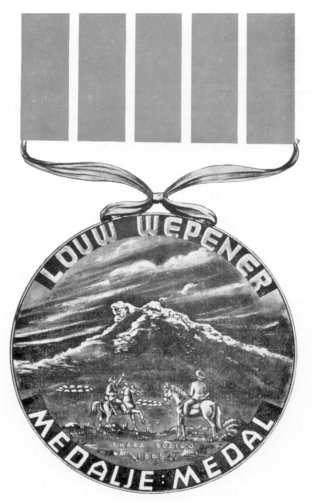

 The South African
The South African
by G.R. DUXBURY
This medal is instituted in honour of Louw Wepener who, in l865 lost his life whilst leading his burghers in an attack on a stronghold on Thaba Bosigo in the Basuto Wars of 1858-1865. At first sight it might appear to overlap the Louw Wepener Decoration instituted on 6th April, 1952 but there is a definite distinction between them. The Decoration is in silver and the Medal in bronze. The Decoration is awarded for acts "of the most conspicuous courage or greatest heroism ...."
To date only four Decorations have been awarded. The small number is probably due to the extremely high rating placed by the authorities on the words "most conspicuous courage or greatest heroism". The Medal will thus enable the authorities to reward those deeds considered courageous or heroic which in their estimation are worthy of an award but fall short of an award of the silver Decoration.
This is in keeping with awards of this nature issued by Great Britain and also South Africa's own queen's Medal for Bravery which was issued (prior to South Africa becoming a Republic) in gold or silver. It will in future be possible to make awards for courageous or heroic acts in the normal sense of these words, which would previously have gone unrewarded. For acts of such great and exceptional gallantry as to merit a special degree of recognition the silver Decoration will, as heretofore, be awarded.
These two awards may, "broadly speaking" be compared to Britain's George Cross and Medal (Military Division).
A recipient who performs a further act of bravery deserving recognition in terms of the warrant may receive a bar. This applies to both Decoration and Medal both of which may be awarded posthumously.
In the case of the Decoration the recipient is entitled to use the letters "LWD" after his name and in the case of the Medal the letters "LWM". As with most South African Decorations the letters are the same in either of the official languages which saves much confusion as in the case of certain previous awards.
The ribbons of both the Decoration and the Medal are orange and white except that whereas that of the Decoration consists of vertical alternating stripes each one-eighth of an inch wide that of the Medal is divided into five vertical panels of equal width by four white stripes each one-sixteenth of an inch wide. The ribbon, which is of silk, is one-and-three-eighths inches in width.
The Medal will be struck in bronze, circular in shape and one-and-a-half inches in diameter. The miniature will be half the size of the Medal.

The obverse is in relief and consists of a mountain peak representing Thaba Bosigo with two men mounted on horseback at its foot. Below the horsemen the words "Thaba Bosigo, 1865". Around the top circumference are the words "LOUW WEPENER" and around the bottom circumference the words "Medalje: Medal". The reverse bears, in relief, the embellished Coat of Arms of the Republic of South Africa. A serial number will be stamped on the rim of every medal.
The bar, also in bronze, is one and three-eighths inches in length by one-quarter of an inch deep with a circular bronze button, embossed with the letters "LWM", attached in the centre. The bar will be worn affixed horizontally to the ribbon of the Medal. When the ribbon only is worn a circular bronze button with the letters "LWM" will be worn on the ribbon to denote the award of a bar.
This Medal appears in the list of precedence with the Van Riebeeck Medal, The South African Police Star for Distinguished Service and the Decoration for Distinguished Service in the South African Railways Police in precedence according to date of award.
There is, unfortunately, still a lack in so far as an award for bravery by civilians is concerned. Prior to South Africa becoming a Republic the need was met by the award of the Queen's Medal for Bravery already mentioned. This Medal (in gold) was reflected in the South African Order of Precedence (published on 1st October, 1954) after the Castle of Good Hope, ranking equally with the Louw Wepener Decoration depending on date of award. The silver medal took precedence equally with the Queen's Police Medal (for Gallantry) and the van Riebeeck Medal according to date of award. In the latest Order of Precedence published in Government Gazette Extraordinary on 6 January, 1967, no mention is made of the Queen's Medal for Bravery.
In the British Order of Precedence the Queen's Medal for Bravery (in gold) takes precedence before the Distinguished Conduct Medal. It is listed as "Union of South Africa Queen's Medal for Bravery, in Gold". The medal in silver takes precedence before the Distinguished Service Medal.
According to advice received from the Prime Minister's Office some time ago consideration was then being given to the institution of one or two awards to take the place of the Queen's Medal for Bravery. At the time it was also stated that if the award is approved it would, subject to consultations being held with the Bureau of Heraldry, retain the design on the reverse of the Queen's Medal for Bravery which depicts Wolraad Woltemade's heroic rescue. This medal with its fine design, struck by the S.A. Mint, has been acclaimed in several countries as one of the finest ever produced.
It is hoped that 1968 will see the appearance of this long awaited award for acts of bravery by civilians.
Return to Journal Index OR Society's Home page
South African Military History Society / scribe@samilitaryhistory.org